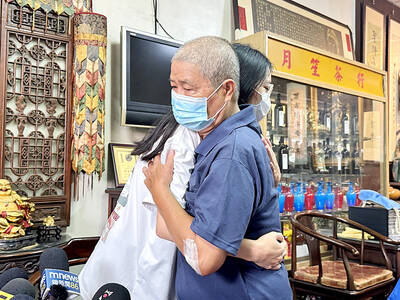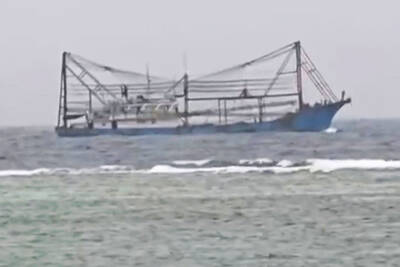A total of 190 clinics have started offering COVID-19 polymerase chain reaction (PCR) testing to help conserve emergency room capacity, the Central Epidemic Command Center (CECC) said yesterday, as it reported 36,168 new domestic COVID-19 cases and 10 deaths.
The center added the clinics to its list of designated community testing sites to provide government-funded PCR tests for people who tested positive in a rapid test or are referred for testing by a doctor, the CECC said.
The list of clinics is available at https://reurl.cc/QjM9bM.

Photo: CNA
People should make an appointment before going to a clinic for a test, the CECC said.
Minister of Health and Welfare Chen Shih-chung (陳時中), who heads the center, said that people who feel they are at risk and have a fever, respiratory symptoms, abnormal taste and smell, or unexplained diarrhea should be tested at a clinic.
People with more serious symptoms — such as difficulty breathing, persistent chest pain, or bluish skin, lips or nails — should go to a hospital, he added.
Other serious symptoms include having a heartbeat of more than 100 beats per minute without a fever; being unable to eat, drink or take medicine; or showing a significant decrease in urine output over a 24-hour period, he said.
The Bureau of Labor Insurance on Thursday said that people covered by the Labor Insurance Program who are unable to work after testing positive for COVID-19 can claim injury or sickness benefits after four days of absence from their job.
For example, someone with the maximum insured monthly salary of NT$45,800 who applied for the benefit from the fourth through the 10th day of their quarantine would receive a one-time payment of about NT$5,340 for the seven-day period, Department of Labor Insurance Director Chen Mei-nu (陳美女) said.
Other workers might receive less than this amount, depending on their insured monthly salary, she added.
Under the program, sickness benefits are calculated at half of a worker’s insured monthly wages.
The Ministry of Labor also adjusted how it calculates sick leave for workers who contract COVID-19, but do not need to be hospitalized.
In a revised interpretation of Regulations of Leave-Taking of Workers (勞工請假規則), workers with COVID-19 who quarantine at home or in designated facilities would be considered as being on “hospitalized” sick leave, meaning they are allowed a maximum of one year of leave within a two-year period, as a 30-day cap for “non-hospitalized” leave was considered insufficient, it said.
The interpretation, which applies retroactively from April 8, also stipulates that sick leave taken by workers with COVID-19 should not be deducted from employers’ calculations for perfect attendance bonuses.
The changes came as the CECC reported another record number of COVID-19 cases at 36,213.
The cases, which were 20 percent higher than a day earlier, consisted of 36,168 domestic cases and 45 from abroad, it said.
The 10 deaths involved four men and six women in their 30s to 90s, who tested positive between April 21 and Tuesday, and passed away between April 29 and Monday, CECC data showed.
The youngest was a man in his 30s who was unvaccinated and had a history of urinary tract stones, while the other nine were all older than 60 and had underlying medical conditions, the data showed.
The center also reported that the number of people with moderate symptoms rose by 76 and the figure for those with severe symptoms rose by 11.

A Chinese aircraft carrier group entered Japan’s economic waters over the weekend, before exiting to conduct drills involving fighter jets, the Japanese Ministry of Defense said yesterday. The Liaoning aircraft carrier, two missile destroyers and one fast combat supply ship sailed about 300km southwest of Japan’s easternmost island of Minamitori on Saturday, a ministry statement said. It was the first time a Chinese aircraft carrier had entered that part of Japan’s exclusive economic zone (EEZ), a ministry spokesman said. “We think the Chinese military is trying to improve its operational capability and ability to conduct operations in distant areas,” the spokesman said. China’s growing

Nine retired generals from Taiwan, Japan and the US have been invited to participate in a tabletop exercise hosted by the Taipei School of Economics and Political Science Foundation tomorrow and Wednesday that simulates a potential Chinese invasion of Taiwan in 2030, the foundation said yesterday. The five retired Taiwanese generals would include retired admiral Lee Hsi-min (李喜明), joined by retired US Navy admiral Michael Mullen and former chief of staff of the Japan Self-Defense Forces general Shigeru Iwasaki, it said. The simulation aims to offer strategic insights into regional security and peace in the Taiwan Strait, it added. Foundation chair Huang Huang-hsiung

PUBLIC WARNING: The two students had been tricked into going to Hong Kong for a ‘high-paying’ job, which sent them to a scam center in Cambodia Police warned the public not to trust job advertisements touting high pay abroad following the return of two college students over the weekend who had been trafficked and forced to work at a cyberscam center in Cambodia. The two victims, surnamed Lee (李), 18, and Lin (林), 19, were interviewed by police after landing in Taiwan on Saturday. Taichung’s Chingshui Police Precinct said in a statement yesterday that the two students are good friends, and Lin had suspended her studies after seeing the ad promising good pay to work in Hong Kong. Lee’s grandfather on Thursday reported to police that Lee had sent

A Chinese ship ran aground in stormy weather in shallow waters off a Philippines-controlled island in the disputed South China Sea, prompting Filipino forces to go on alert, Philippine military officials said yesterday. When Philippine forces assessed that the Chinese fishing vessel appeared to have run aground in the shallows east of Thitu Island (Jhongye Island, 中業島) on Saturday due to bad weather, Philippine military and coast guard personnel deployed to provide help, but later saw that the ship had been extricated, Philippine navy regional spokesperson Ellaine Rose Collado said. No other details were immediately available, including if there were injuries among